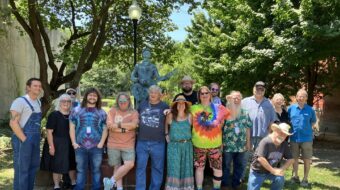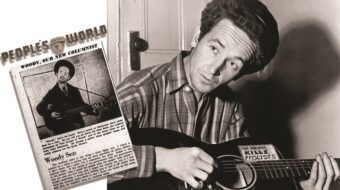
Earlier this year, for African-American History Month, New York City’s The Dessoff Choirs, based in New York City, and its conductor Malcolm J. Merriweather released world-premiere recordings of Credo and Simon Bore the Cross, two cantatas by 20th-century African-American Chicago-born composer Margaret Bonds (1913-72). Both works show the influence of passionately committed Christian thought, or what today we would call “liberation theology.”
The Dessoff Choirs had previously released its recording MARGARET BONDS: The Ballad of the Brown King & Selected Songs.
Credo is set to radical historian and activist (and late in life a Communist Party member) W.E.B. Du Bois’s 1904 prose poem. Simon Bore the Cross was a collaboration between Bonds and her close friend and collaborator, Langston Hughes (1901-67). The recording features the chorus with full orchestra and magnificent soloists soprano Janinah Burnett and bass-baritone Dashon Burton.
The Dessoff Choirs performs Credo from an authoritative edition by Temple University music professor Rollo Dilworth, while the edition and orchestration of Simon Bore the Cross is by the Choirs’ Maestro Merriweather. The album’s liner notes are provided by leading Bonds authority Dr. Ashley Jackson.
Perhaps among Du Bois’s lesser-known writings, Credo’s seven-part prose poem is in many ways typical in his lyrical evocation of what he would elsewhere call The Souls of Black Folk, a widely read and still seminal work of history and sociology dating from 1903, just the year before. It’s almost as though Du Bois (1868–1963) had been asked point blank, “Dr. Du Bois, can you briefly summarize for us exactly what you believe?” and that’s just what he set to do.
Bonds collaborates with her own vocal writing style, here graceful and poetic, then suffused with the elemental power of various black musical genres. It’s interesting to contemplate that over 90% of the composer’s works contain text. Clearly it was text that inspired her creative juices to flow. She often set the words of Black writers; and by centering their words, she dialogues with and honors the accomplishments of both her ancestors and contemporaries.
Simon Bore the Cross and Credo were products of the last decade of Bonds’s life. They reflect the late stages of her unique musical language that had ripened over a lifetime that, alas, was shortened by her premature death at 59. Despite plans for both publication and premieres of these two works, neither was achieved during the composer’s lifetime. She began Credo after Du Bois died in 1963, writing to his widow, Shirley Graham Du Bois, looking ahead “to a time when Credo will move all over the world.” Credo’s first complete performance took place a year after Bonds died and garnered favorable reviews. The Los Angeles Times wrote of the Los Angeles Philharmonic premiere under Zubin Mehta that it “verified her talent, her sensitivity, her proficiency as orchestrator and her concern for the Negro spiritual.”

Simon Bore the Cross focuses its eye on Simon of Cyrene from North Africa, who carried Jesus’ cross along part of the way to Calvary. In Simon, as a key character in the passion narrative, Bonds and Hughes gave African-American audiences the window through which to position themselves within the biblical canon. Hughes began working on this text in 1962, and Bonds completed her piano-vocal score in 1965. Bonds had met Langston Hughes some three decades before, during the heyday of the Harlem Renaissance, and they became almost like artistic sister and brother: Bonds set numerous Hughes poems to music.
The character of Simon is somewhat foggy, with scant scriptural authority. Identified as a Cyrene, he came from the Greek province of Cyrenaica in what is now eastern Libya. The Jewish community there had been established under the reign of Ptolemy Soter (323-285 BCE), when he forced some 100,000 Judean Jews to resettle there. The Cyrenian Jews maintained a synagogue in Jerusalem, so possibly Simon had made a Passover pilgrimage there (if he was even Jewish, which is unknown) and had become a follower of Jesus. The scant accounts of him suggest that the Romans spotted this dark-featured man in the crowd and forced him to come out and help Jesus bear the cross. In any case, he has come down as an African-American folk hero that Hughes and Bonds chose to celebrate.
“uncursed by color”
Credo bears similarity to other well-known American choral testimonials to the belief in freedom and democracy, along them Randall Thompson’s Testament of Freedom, Earl Robinson’s Ballad for Americans, and Marc Blitzstein’s Airborne Symphony. The overall tone is high-minded, sacred, virtuous, patriotic, earnest.
In the noble first section, “I Believe in God,” Du Bois immediately identifies the deity not as the creator of the universe but as one “who made of one blood / all nations that on earth do dwell. / I believe that all men, / black and brown and white, are brothers, / varying through time and opportunity, / in form and gift and feature, / but differing in no essential particular, / and alike in soul / and the possibility of infinite development.”
The historical proximity of his Souls of Black Folk leads Du Bois directly into section 2, “Especially Do I Believe in the Negro Race,” “in the beauty of its genius, / the sweetness of its soul / and its strength in that meekness / that shall yet inherit this turbulent earth.” The poet summons up the Biblical promise, from Jesus’s Sermon on the Mount, that “the meek shall inherit the earth.” Here the high soprano, with an impressively rendered blue note on the word “meekness,” dominates the movement, with the chorus joining in.
Part 3, the declamatory “I Believe in Pride of Race,” affirms pride of lineage so long as it does not diminish any other, then embarks on a paean to the rewards of labor. “I believe in Service, humble, rev’rent service. / From the blackening of boots to the whitening of souls: / for work is Heaven, Idleness, Hell, / and wage is the ‘Well done!’ of the Master, / who summoned all them that labor and are heavy laden, / making no distinction between the black, / sweating cotton hands of Georgia / and the first families of Virginia, since all distinction / not based on deed is devilish / and not divine.”
If those words might imply that the slave’s and the Master’s work are equally valid, in section 4, “I Believe in the Devil,” Du Bois quickly disabuses us of that assumption. “I believe in the Devil and his Angels, / who wantonly work to narrow / the opportunity of struggling human beings, /especially if they be black; / … Hating the image which their Maker stamped on a brother’s soul.” Bonds uses discordant harmonies here, underscoring that the Devil acts through racism.
The Prince of Peace is the subject of the next section, written at the very height of global imperialism. As an American, he had just witnessed the U.S. joining the imperial club by seizing Cuba, Puerto Rico, Hawaii and the Philippines. Already in 1904, Du Bois had seen enough of colonial wars, yet the Russo-Japanese War, two world wars, the Korean War, and even the first U.S. involvement in Vietnam still lay ahead in his long lifetime, not to mention many further attempts by European powers to secure their empires over darker peoples. In the end, Du Bois predicts, such wars will be the demise of their dominion. “I believe that War is Murder. / I believe that armies and navies are at the bottom / the tinsel and braggadocio of oppression and wrong, / and I believe that the wicked conquest / of weaker and darker nations by nations whiter and stronger / but foreshadows the death of that strength.” The chorus in this minor key movement repeats “I Believe in the Prince of Peace” over and over, as though a mantra to always keep in mind.
Liberty is the belief affirmed in section 6, led by the bass soloist. This is an anti-Jim Crow appeal, an egalitarian, humanitarian vision for all to have “the space to stretch their arms and their souls, / the right to breathe and the right to vote, / the freedom to choose their friends, / enjoy the sunshine, and ride on the railroads, / uncursed by color….” In dreamy, heavenly tones, Bonds calls up the 23rd Psalm’s “green pastures” and “still waters” for Du Bois’s “large vision of beauty and goodness and truth,” as he warns that, like Esau, some may come along and “for mere meat barter their birthright in a mighty nation.”
And then, “Finally, finally, finally,” in the concluding section, Christ-like himself—and indeed like Lenin, who more than once told his followers that they must always and constantly, “patiently explain” their views to the masses—Du Bois believes in “patience with the weakness of the Weak / and the strength of the Strong. / The prejudice of the Ignorant / and the ignorance of the Blind. / …patience with the tardy triumph of joy / and the mad, mad, mad chastening of Sorrow.” He ends with what he began: “Patience with God!”
The dark man’s name is Simon
Simon Bore the Cross is a passion story, a restatement in text and music of the forced procession to Calvary. In an overture and seven vocal movements capturing the Stations of the Cross, Hughes and Bonds recount the trial and agony of Jesus on the last day of his life, from Pilate’s washing his hands of the case to the trial, where Jesus is lynched, and ultimately to the crucifixion and resurrection. It’s the appearance of Simon, unknown, unrecognized, but repeatedly referred to as “dark,” that forms the centerpiece of this particular story.
Did you hear, did you hear, Mary,
the dark man came from Cyrene?
God has sent his servant to walk with Jesus,
black men, will share the pain of the cross,
black men will share the pain.
In a world, in a world, Mary,
that’s filled with trials and troubles,
Simon out of Africa shares your sorrow.
Black men will share the pain of the cross.
Simon bears the cross, Mary. Simon bears the cross!”

Written in the midst of the militantly peaceful civil rights struggle in the United States, the text (and the oratorio) call out for recognizing two things: that “the African bore the cross, / the cross to save our souls,” fighting for themselves when many if not most people who called themselves Christian had deserted them. And that the movement called out for solidarity. “Walkin’ to Calvary / Heavy-laden and weary of heart, / Jesus and Simon, stumbling and stagg’ring… / brothers together, they walked, / and the African was strong, / trudging on in the dust of humanity’s disgrace….”
The parallel between the crucifixion and lynching is made more explicit when Hughes states, “They nailed him to a tree / and he never said a mumblin’ word, / not a word,” at a climactic moment in the score. Hughes was surely not advocating passivity or silence, but it is telling that he recognized the strategy of nonviolent resistance. As poetic license he overlooks the New Testament accounts relating the last statements of Jesus from the cross, known as the Seven Last Words of Christ (“Forgive them, Lord, they know not what they do”).
The piece ends in a chorale of catharsis with the Resurrection. “[N]ow my heart takes wing this morning / like a bird that flies away, / flies away, flies away…. Wings of morning, Alleluia, / Amen, amen, amen.” Like the Rev. Martin Luther King Jr. and so many other leaders of faith, Hughes understood the story of Jesus and the Resurrection in its deepest significance—hope, solidarity, freedom, and patience.
Simon, otherwise a completely anonymous outsider to the story, stepped in when the pain of humanity called out to him. And why don’t you, beloved listener, why don’t you?
Textually and musically, we can be grateful that these stunning works can now be heard and appreciated. Click here to hear excerpts from both of these compositions. A quick Internet search reveals upcoming performances of Credo—in Boston on June 8, 2024, for example. A performance of Credo by the Conspirare vocal ensemble can be watched in an hour-and-a-half concert here, starting at 68 minutes after a generous introductory program of poetry and music featuring the work of both Hughes and Bonds.
Margaret Bonds
Credo and Simon Bore the Cross
The Dessoff Choirs
Malcolm J. Merriweather, conductor
Avie Records AV2589, 2023
63 minutes
We hope you appreciated this article. At People’s World, we believe news and information should be free and accessible to all, but we need your help. Our journalism is free of corporate influence and paywalls because we are totally reader-supported. Only you, our readers and supporters, make this possible. If you enjoy reading People’s World and the stories we bring you, please support our work by donating or becoming a monthly sustainer today. Thank you!












Comments